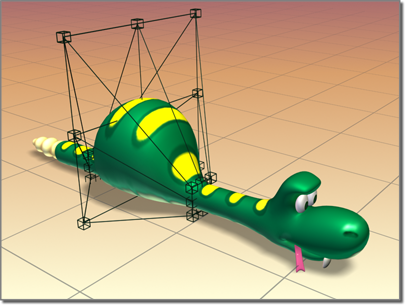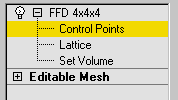FFD stands for Free-Form Deformation. Its effect is used in computer animation for things like dancing cars and gas tanks. You can use it as well for modeling rounded shapes such as chairs and sculptures.
The FFD modifier surrounds the selected geometry with a lattice. By adjusting the control points of the lattice, you deform the enclosed geometry.

FFD deformation creates a bulge in the snake.
There are three FFD modifiers, each providing a different lattice resolution: 2x2, 3x3, and 4x4. The 3x3 modifier, for example, provides a lattice with three control points across each of its dimensions or nine on each side of the lattice.
There are also two FFD-related modifiers that provide supersets of the original modifiers; see FFD (Box/Cyl) modifier. With the FFD (Box/Cyl) modifiers, you can set any number of points in the lattice, which makes them more powerful than the basic FFD modifier.
Animating FFD Control Points and the Master Point Controller
Turn on the Auto Key button and move the lattice points to animate an FFD and any underlying geometry. When you animate FFD control points, a Master Point Controller is created automatically. In Track View the master controller allows you to move multiple animated control points in time by simply moving one master key (master keys display green in Track View).

At this sub-object level, you can select and manipulate control points of the lattice, one at a time or as a group (select multiple points using standard techniques). Manipulating control points affects the shape of the underlying object. You can use standard transformation methods with the control points. If the Auto Key button is turned on when modifying the control points, the points become animated.
At this sub-object level, you can position, rotate, or scale the lattice box separately from the geometry. If the Auto Key button is turned on, the lattice becomes animated. When you first apply an FFD, its lattice defaults to a bounding box surrounding the geometry. Moving or scaling the lattice so that only a subset of vertices lies inside the volume makes it possible to apply a localized deformation.
The lattice volume defaults to the bounding box of the selected geometry. However, you can position, rotate, and/or scale the lattice box so that it modifies only a subset of vertices. Choose the Lattice sub-object level, and then use any of the transform tools to adjust the lattice volume relative to the geometry.
At this sub-object level, the deformation lattice control points turn green, and you can select and manipulate control points without affecting the modified object. This lets you fit the lattice more precisely to irregular-shaped objects, giving you finer control when deforming.
Set Volume essentially lets you set the initial state of the lattice. If you use it after you have animated a control point or when the Auto Key button is turned on, then it works the same as at the Control Points sub-object level, deforming the object as you manipulate points.
For more information on the stack display, see Modifier Stack.
Assigns Point3 controllers to all control points so that they're immediately visible in Track View.
By default the control points of an FFD lattice don't appear in Track View because they don't have controllers assigned to them. But when a control point is animated, a controller is assigned to it and becomes visible in Track View. With Animate All, you can add and delete keys and perform other key operations.
FFD stands for Free-Form Deformation. Its effect is used in computer animation for things like dancing cars and gas tanks. You can use it as well for modeling rounded shapes such as chairs and sculptures.
The FFD Select modifier works on an FFD (Box) Space Warp or FFD (Cyl) Space Warp to change the selection of its control points, and pass the selection up the stack.